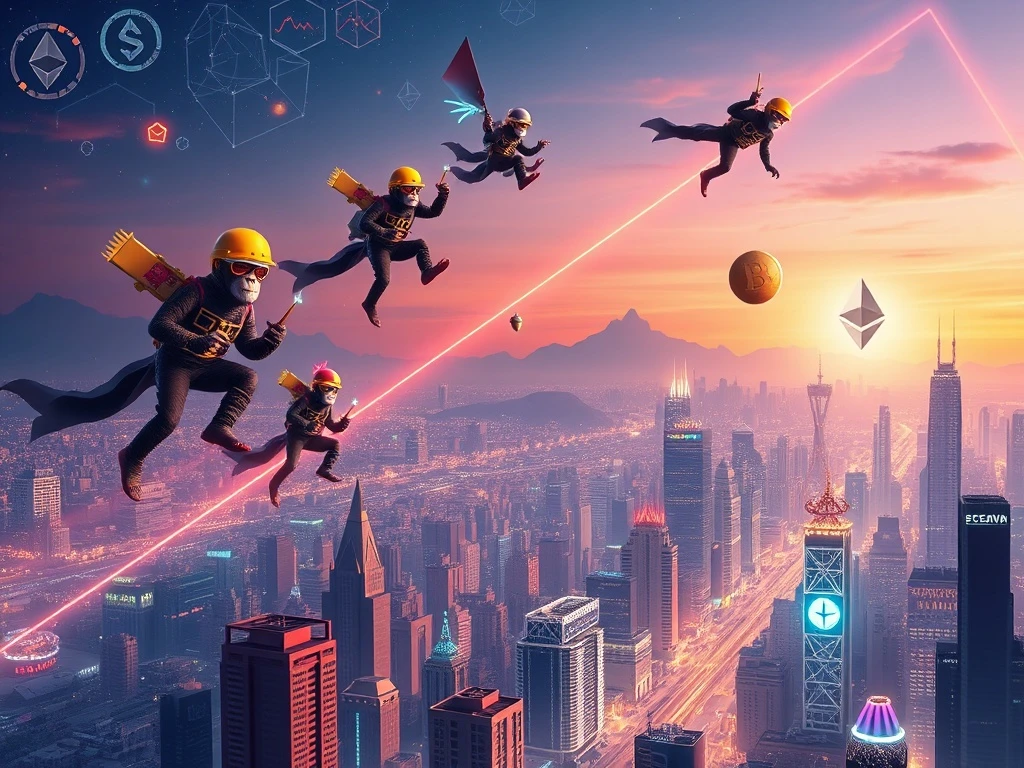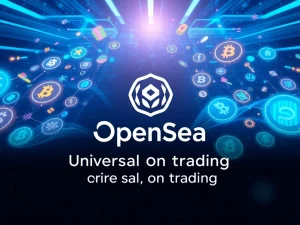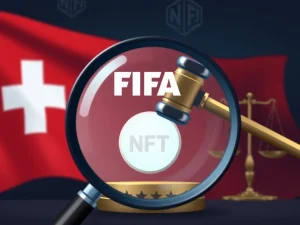Phenomenal NFT Market Surge: CryptoPunks Sale Ignites $6.6 Billion Boom

The world of digital assets is buzzing once again! If you’ve been watching the crypto space, you’ve likely noticed a significant uptick in activity, particularly within the non-fungible token (NFT) sector. A monumental CryptoPunks sale recently made headlines, signaling a robust resurgence in the market and drawing considerable attention from both seasoned investors and new enthusiasts. This isn’t just a fleeting moment; it points to deeper shifts within the Blockchain Ecosystem.
What’s Driving the Current NFT Market Surge?
The past few months have been nothing short of remarkable for NFTs. The market has witnessed a phenomenal NFT Market Surge, with its overall capitalization soaring to an impressive $6.6 billion in July. This represents a staggering 94% increase from earlier levels, a clear indicator of renewed confidence and interest. But what’s truly fueling this momentum?
- High-Value Transactions: A single buyer recently acquired six rare, hooded CryptoPunks for over $4.3 million via OpenSea. This significant purchase, one of the largest in recent months, underscores a growing appetite for blue-chip digital assets.
- Blue-Chip Collection Gains: Top-tier Digital Collectibles are leading the charge. CryptoPunks saw its floor price jump 29% to $190,000, Pudgy Penguins soared by 66.7%, and Bored Ape Yacht Club (BAYC) experienced a solid 9.8% gain. These gains highlight a shift towards scarcity-driven assets, where rarity and established provenance command premium prices.
- Shifting Investor Behavior: The broader NFT market’s 66% growth over 30 days suggests a more mature approach from investors. Instead of speculative flips, there’s an increasing focus on long-term value and perceived scarcity.
While the current market activity remains below the $16.6 billion peak observed in 2021 and 2022, it signifies a healthy recalibration rather than a mere rebound to previous highs. The sector is adapting, with platforms like X2Y2, once dominant, shuttering operations due to declining activity, while remaining platforms are diversifying their trading strategies to stay relevant.
The Role of Ethereum and the Broader Blockchain Ecosystem
Many analysts attribute the current surge to the increasing adoption of Ethereum and the ripple effects of ETF-related inflows into the broader crypto market. While these factors haven’t directly translated into NFT trading volume, they undoubtedly contribute to a positive sentiment across the entire Blockchain Ecosystem. A stronger, more robust underlying blockchain infrastructure naturally provides a more stable foundation for NFTs to thrive.
The growing utility and acceptance of Ethereum as the primary network for many high-value NFTs reinforce their long-term potential. As the ecosystem matures, so does the understanding and perceived value of the digital assets built upon it. This interconnectedness means that improvements and wider adoption in one area of crypto often benefit others.
Navigating Volatility: Is This the Right Time for NFT Investment?
Despite the exciting gains and high-profile sales, the NFT market isn’t without its challenges. The recent 27% decline in overall NFT sales over the past month, following a June trading volume peak of $51 million, points to short-term volatility. This suggests that while there’s strong demand for specific, high-value assets, the broader market can still experience significant fluctuations.
For those considering NFT Investment, caution remains paramount. Experts advise that while demand for blue-chip NFTs is strong, the sustainability of recent price and volume growth remains uncertain, particularly amid broader macroeconomic pressures and speculative trading patterns. It’s crucial to understand that not all NFTs are created equal, and the market often behaves differently for established collections versus newer, less liquid projects.
Key Considerations for Potential Investors:
- Research is King: Thoroughly investigate the collection, its community, utility, and the team behind it.
- Understand Liquidity: High-value Digital Collectibles like CryptoPunks have more liquidity than niche projects, but sales can still take time.
- Market Sentiment: High-value transactions, like the doubling of a buyer’s CryptoPunks holdings to 12, often serve as market sentiment indicators, reinforcing the influence of high-profile platforms like OpenSea.
- Risk Management: Only invest what you can afford to lose. The market is still relatively young and subject to rapid shifts.
Beyond Speculation: The Evolution of Digital Collectibles
The current market resurgence aligns with a broader maturation of the crypto ecosystem, where NFTs are increasingly perceived as store-of-value assets rather than purely speculative commodities. This fundamental shift in perception is critical for the long-term health of the market. When assets are viewed as having intrinsic or enduring value, they attract a different class of investor, including institutional participants.
This evolution is particularly evident in the sustained interest in blue-chip Digital Collectibles. These aren’t just jpegs; they represent cultural milestones, technological innovation, and a new paradigm for digital ownership. As the NFT landscape continues to evolve, regulatory clarity and platform interoperability will undoubtedly play critical roles in shaping its next phase of growth, making it more accessible and secure for a wider audience.
Conclusion: A New Chapter for NFTs?
The recent NFT Market Surge, spearheaded by the impressive CryptoPunks sale and the robust performance of other blue-chip Digital Collectibles, marks an exciting chapter for the digital asset space. While volatility remains a factor, the underlying trends suggest a move towards greater maturity and a recognition of NFTs as legitimate, scarcity-driven assets within the broader Blockchain Ecosystem. For those eyeing NFT Investment, this period presents both opportunities and a reminder for diligent research and cautious optimism. As the market continues to define itself, the focus on genuine value and community will likely pave the way for sustainable growth.
Frequently Asked Questions (FAQs)
Q1: What is driving the recent NFT market surge?
The recent surge is primarily driven by high-value transactions, renewed institutional and retail interest in blue-chip digital collectibles like CryptoPunks, and a general shift towards scarcity-driven assets. The broader positive sentiment in the blockchain ecosystem, partly due to Ethereum’s adoption, also plays a role.
Q2: How significant was the CryptoPunks sale?
A single buyer acquired six rare hooded CryptoPunks for over $4.3 million through OpenSea. This was one of the largest NFT purchases in recent months and significantly contributed to the overall market capitalization increase.
Q3: Are NFTs becoming a stable investment?
While the market is showing signs of maturation and NFTs are increasingly perceived as store-of-value assets, short-term volatility still exists. The market experienced a 27% decline in sales volume in the past month, indicating that while demand for top-tier assets is strong, the sector remains subject to fluctuations. It’s crucial to approach NFT investment with caution and thorough research.
Q4: What are blue-chip NFTs?
Blue-chip NFTs refer to established, highly valuable, and generally well-known collections that have demonstrated sustained demand and cultural significance. Examples include CryptoPunks, Bored Ape Yacht Club, and Pudgy Penguins, which often command higher floor prices and are seen as more stable investments within the NFT space.
Q5: What challenges does the NFT market still face?
The NFT market still faces challenges such as short-term volatility, the need for greater regulatory clarity, and the ongoing impact of macroeconomic pressures. Additionally, platform interoperability and adapting to evolving user demands are key areas for future development.
Q6: How does the current NFT market compare to its peak in 2021-2022?
The current market capitalization of $6.6 billion, while impressive, remains below the $16.6 billion peak observed in 2021 and 2022. This suggests a more sustainable, perhaps less speculative, growth phase compared to the previous bull run, indicating structural changes and a focus on long-term value rather than just hype.









